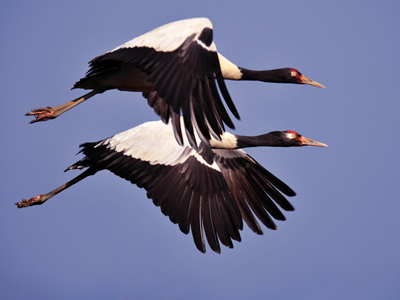 We asked our staff for their top ten facts about crane migration to create this list – we hope you are inspired to learn more about the mystery of bird migration!
We asked our staff for their top ten facts about crane migration to create this list – we hope you are inspired to learn more about the mystery of bird migration!
1. Lesser Sandhill Cranes have the longest migration, flying between their breeding and wintering grounds as far as northeastern Siberia and northern Mexico each year!
2. Not all cranes migrate great distances, including the Wattled, Blue and Crowned Cranes in Africa, which move seasonally within their ranges in Africa.
3. Migration is the most dangerous time for cranes, due to habitat loss along flyways, powerline collisions and shootings…and they must do this twice a year!
4. Crane chicks complete their first migration with their parents, who teach the young birds their migratory route.
5. Some Sandhill Cranes breed as far north as Siberia and migrate to their wintering areas in the southwestern United States and northern Mexico.
6. Cranes do not recognize political boundaries during migration, which unites diverse countries under the common goal of safeguarding cranes.
7. Demoiselle Cranes, the smallest crane species, migrate over the Himalayas, crossing the mountain range at an altitude of up to 26,000 feet to reach their wintering areas in India.
8. In Southeast Asia, Sarus Cranes nest in small wetlands in the forests of northern Cambodia and migrate to the Mekong River basin in Vietnam for the winter.
9. The migrations of White-naped, Hooded and Red-crowned Cranes connect the wetlands of Mongolia, northern China and southeastern Russia with eastern China, the Korean Demilitarized Zone and Japan.
10. Cranes can cover an average of 200 miles on a single day during migration by using thermals, or updrafts of warm air, to gain elevation and glide great distances.
